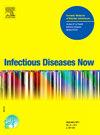Auvergne-Rhône-Alpes地区1295张达托霉素处方的多中心审核。
IF 2.2
4区 医学
Q2 INFECTIOUS DISEASES
引用次数: 0
摘要
目的:对Auvergne-Rhône-Alpes地区住院患者的达托霉素处方进行审核。审计是在旨在提高医院与区域卫生机构之间病人护理质量和效率的合同范围内进行的。患者和方法:本研究采用临床审计方法,对2023年收集的数据进行回顾性多中心研究。当地相关医疗保健专业人员根据计算机化医疗记录中提供的数据,根据指南评估处方的适当性。结果:共纳入50家医院达托霉素处方1295张。患者中位年龄为72 岁(61-80岁)。大多数处方是针对骨和关节感染(n = 573,44.2% %),最常见于骨科病房(n = 445,34.4 %)。40.5 % (n = 524)的病例获得细菌学记录。87.1 % (n = 1128)认为处方适宜。132不合适的处方为120名患者被确认:33.3 % (n = 44)是不适当的迹象,25 % (n = 33)由于缺乏降级后微生物文档,16.7 % (n = 22)不适当的剂量和15.9 % (n = 21)不恰当的治疗持续时间有关。在38.8% % (n = 503)的处方中发现了治疗传染病的书面建议;结论:本研究发现,Auvergne-Rhône-Alpes地区达托霉素处方的适宜性总体上令人满意,但其应用的自评方法存在一定的局限性。此外,还确定了达托霉素处方中有待改进的地方。本文章由计算机程序翻译,如有差异,请以英文原文为准。
A multicenter audit of 1295 daptomycin prescriptions in the Auvergne-Rhône-Alpes region
Objective
We conducted an audit of daptomycin prescriptions for patients hospitalized in the Auvergne-Rhône-Alpes region. The audit was performed in the scope of contracts designed to improve the quality and efficiency of patient care between hospitals and the regional health agency.
Patients and method
This retrospective multicenter study was conducted using the clinical audit method on data collected in 2023. The local referent healthcare professional assessed prescription appropriateness with regard to guidelines, based on data available in computerized medical records.
Results
All in all, 1295 daptomycin prescriptions from 50 hospitals were included. Median patient age was 72 years (61–80). A majority of prescriptions were initiated for bone and joint infections (n = 573, 44.2 %), most often in orthopedic wards (n = 445, 34.4 %). Bacteriological documentation was obtained in 40.5 % (n = 524) of cases. The prescription was considered appropriate in 87.1 % (n = 1128).
A total of 132 inappropriate prescriptions for 120 patients were identified by the local referent healthcare professional: 33.3 % (n = 44) were inappropriate indications, 25 % (n = 33) were due to a lack of de-escalation following microbiological documentation, 16.7 % (n = 22) involved inappropriate dosing and 15.9 % (n = 21) concerned inappropriate treatment duration. Written recommendations for treatment of an infectious disease physician were found for 38.8 % (n = 503) of prescriptions; they were associated with higher appropriateness (386/410 (94.1 %) vs. 65/93 (69.9 %), p < 0.01).
Conclusion
This study found that while appropriateness of daptomycin prescriptions in Auvergne-Rhône-Alpes was generally satisfactory, it was limited by the self-evaluation method applied. In addition, areas for with potential for improvement in daptomycin prescription were identified.
求助全文
通过发布文献求助,成功后即可免费获取论文全文。
去求助
来源期刊

Infectious diseases now
Medicine-Infectious Diseases
CiteScore
7.10
自引率
2.90%
发文量
116
审稿时长
40 days
 求助内容:
求助内容: 应助结果提醒方式:
应助结果提醒方式:


